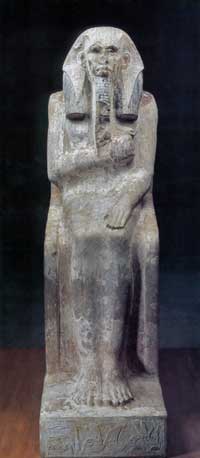 |
| Stepped Pyramid courtesy of Su of Egyptian Monuments |
What comes to your mind when you think of Ancient Egypt? Is it the lavish tombs of the New Kingdom found in the Valley of the Kings? Or is it the jewelry and opulent coffins in which the kings were buried? All of these things should conjure up images in your mind of the beauty and majesty of Egypt that once dominated the Ancient Near East. Of course the pyramids should be atop that list! Well, in the following paragraphs, there are two that set such an elaborate project in the motion. This is the story of a pharaoh and his architect.
 |
| Seated Djoser. Notice the positions of his arms Courtesy of OdyssseyAdventures |
 |
| Imhotep with Scroll Courtesy of TimeTrips |
If you thought that we knew very little about Netjerikhet, we know even less about Imhotep except that he was in the employ of three or four pharaohs, one of them was the above-mentioned Sekhemet, Netjerikhet's successor. Guenter Risse offers the most information about Imhotep in a particular article entitled, Imhotep and Medicine. According to Risse of the Western Journal of Medicine, Imhotep was the first physician to stand out in antiquity. His humility is what struck Risse stating that Imhotep never bore the name of swnw or physician (Risse 1986). It is also Imhotep who not only was venerated in later centuries but also but Greek mercenaries who equated him to their god Asclepius who was in turn god of medicine. What of his pyramid though? Well, it was customary and imperative for pharaohs to construct tombs in order to secure their place in the afterlife thereby perpetuating the existence of the universe. This was no different with Netjerikhet who undertook the largest stone edifice the world had seen. It was to be the crowning achievement of his kingship. Instead of constructing mastabas like the pyramids of before Imhotep and Netjerikhet conceived a new idea of tomb. The tomb itself is a six layered pyramid with a height of 62 metres or 204 feet. It had courtyards and temples and chapels that covered an area of 40 acres. It was indeed a splendid construct of ingenuity and sheer genius by both Netjerikhet and Imhotep.
In conclusion, Netjerikhet's 19 year reign is marked by not only military expeditions into the Sinai but the great Step Pyramid itself truly defined both careers whilst deifying Imhotep in later centuries especially in the Saite Period and Ptolemaic Period when the Greek mercenaries worshipped him as a god of medicine due to his occupation of physician. Netjerikhet and Imhotep were two peas in a pod having thus conceived of an edifice that turned Egypt upside down and launched a campaign of one-up-manship for the next three dynasties thereby ushering in the Age of the Pyramids.
| Djoser's Pyramid Complex courtesy of TimeTrips |
References
Risse, Guenter. 1986. Medicine in Perspective: Imhotep and Medicine A Re-Evaluation. Western Journal of Medicine.
Kinnear, Jacques. 2015. Biography of Horus Netjerikhet. http://www.ancient-egypt.org/history/early-dynastic-period/3rd-dynasty/horus-netjerikhet/biography-of-horus-netjerik.html#previous-photo



